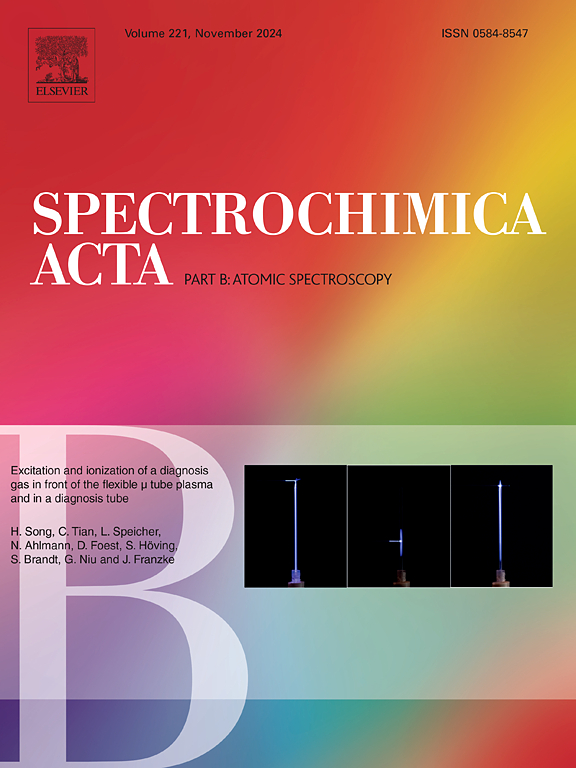水下微像长脉冲LIBS系统:开发与初步测试
IF 3.8
2区 化学
Q1 SPECTROSCOPY
引用次数: 0
摘要
近年来,基于激光诱导击穿光谱(LIBS)技术的水下系统成功地对海水和海底矿物进行了元素分析。长脉冲LIBS在深海矿物原位探测中已显示出其优势。然而,目前深海长脉冲LIBS系统面临着系统尺寸大、对商用长脉冲激光器的需求以及缺乏同步成像能力等挑战。这些问题在一定程度上阻碍了长脉冲LIBS在深海勘探中的进一步应用。本文首次提出了一种具有集成显微成像功能的小型深海长脉冲LIBS原位探测系统(iLIBSea)。该系统采用定制设计的市购紧凑型长脉冲激光器,并集成了一个同步显微成像模块,其视场尺寸为1.46*1.46 mm,横向分辨率为7.8 μm。该系统最大作业深度为5000米,总重量为60千克。通过特殊的设计,最大限度地保留了紫外光谱信号。以4 mJ的低能量实现了高质量的光谱检测,对Cu和Mn的检出限分别为97.1 ppm和21.7 ppm。长脉冲LIBS在模拟50mpa压力条件下也能获得高质量的光谱。随着系统的进一步小型化,长脉冲LIBS系统将在深海矿产勘查中得到广泛应用。本文章由计算机程序翻译,如有差异,请以英文原文为准。

An underwater microimage long-pulse LIBS system: Development and preliminary testing
In recent years, underwater systems based on Laser-Induced Breakdown Spectroscopy (LIBS) technology have successfully performed elemental analysis of seawater and seabed minerals. Long-pulse LIBS has demonstrated its advantages for deep-sea mineral in-situ detection. However, current reports on deep-sea long-pulse LIBS systems face challenges such as large system size, the requirement for commercial long-pulse laser, and the lack of synchronized imaging capabilities. These issues have somewhat hindered the further application of long-pulse LIBS in deep-sea exploration. This paper presents, for the first time, a miniaturized deep-sea long-pulse LIBS in-situ detection system with integrated microscopic imaging capabilities (iLIBSea). The system uses a custom-designed, commercially available compact long-pulse laser, and incorporates a synchronized microscopic imaging module with a 1.46*1.46 mm field of view and a lateral resolution of 7.8 μm. The system has a maximum operational depth of 5000 m and a total weight of 60 kg. Through special design, the ultraviolet spectral signal is preserved to the maximum extent. High-quality spectral detection was achieved with a low energy of 4 mJ, and the detection limits for Cu and Mn were determined to be 97.1 ppm and 21.7 ppm, respectively. And the long-pulse LIBS was able to acquire high-quality spectra even under simulated 50 MPa pressure conditions. With the further system miniaturization, the long-pulse LIBS system would be widely used in deep-sea mineral exploration.
求助全文
通过发布文献求助,成功后即可免费获取论文全文。
去求助
来源期刊
CiteScore
6.10
自引率
12.10%
发文量
173
审稿时长
81 days
期刊介绍:
Spectrochimica Acta Part B: Atomic Spectroscopy, is intended for the rapid publication of both original work and reviews in the following fields:
Atomic Emission (AES), Atomic Absorption (AAS) and Atomic Fluorescence (AFS) spectroscopy;
Mass Spectrometry (MS) for inorganic analysis covering Spark Source (SS-MS), Inductively Coupled Plasma (ICP-MS), Glow Discharge (GD-MS), and Secondary Ion Mass Spectrometry (SIMS).
Laser induced atomic spectroscopy for inorganic analysis, including non-linear optical laser spectroscopy, covering Laser Enhanced Ionization (LEI), Laser Induced Fluorescence (LIF), Resonance Ionization Spectroscopy (RIS) and Resonance Ionization Mass Spectrometry (RIMS); Laser Induced Breakdown Spectroscopy (LIBS); Cavity Ringdown Spectroscopy (CRDS), Laser Ablation Inductively Coupled Plasma Atomic Emission Spectroscopy (LA-ICP-AES) and Laser Ablation Inductively Coupled Plasma Mass Spectrometry (LA-ICP-MS).
X-ray spectrometry, X-ray Optics and Microanalysis, including X-ray fluorescence spectrometry (XRF) and related techniques, in particular Total-reflection X-ray Fluorescence Spectrometry (TXRF), and Synchrotron Radiation-excited Total reflection XRF (SR-TXRF).
Manuscripts dealing with (i) fundamentals, (ii) methodology development, (iii)instrumentation, and (iv) applications, can be submitted for publication.

 求助内容:
求助内容: 应助结果提醒方式:
应助结果提醒方式:


